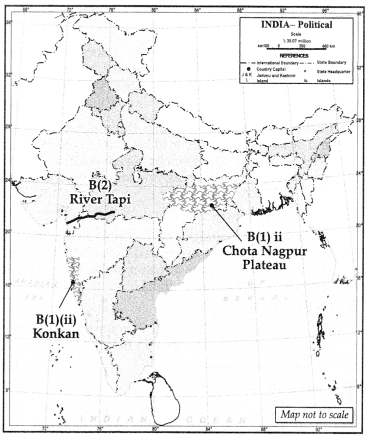Students must start practicing the questions from CBSE Sample Papers for class 9 Social Science with Solutions Set 3 are designed as per the revised syllabus.
CBSE Sample Papers for Class 9 Social Science Set 3 with Solutions
Time Allowed: 3 hours
Maximum Marks: 80
General Instructions:
- Question paper comprises five Sections – A, B, C, D, and E. There are 37 questions in the question paper. All questions are compulsory.
- Section A – From questions 1 to 20 are MCQs of 1 mark each.
- Section B – Questions no. 27 to 24 are Vert,’ Short Answer Type Questions, carrying 2 marks each. The answer to each question should not exceed 40 words.
- Section C – Questions no.25 fy29 are Short Answer Type Questions, carrying 3 marks each. The answer to each question should not exceed 60 words.
- Section D – Questions no. 30 to 33 are Long Answer Type Questions, carrying 5 marks each. Answer to each question should not exceed 720 words.
- Section E – Questions no. from 34 to 36 are Case Based Questions with three sub-questions and are of 4 marks each.
-
Section F – Question no. 37 is Map based, carrying 5 marks with two parts, 37a from History (2 marks) and 37b from
Geography (3 marks). - There is no overall choice in the question paper. However, an internal choice has been provided in a few questions. Only one of the choices in such questions has to be attempted.
- In addition to this, separate instructions are given with each section and question, wherever necessary.
Section-A
MCQs
(1 x 20 = 20 Marks)
Question 1.
Choose the correct option from columns I and II [1]
| Column-I | Column-II |
| (a) The Broken Chian | (1) Symol Of Royal Power |
| (b) The Bundle Of Rods Or Fasces | (2) Act Of Becoming Free |
| (c) Sceptre | (3) Strength Lies In Unity |
| (d) Snake Biting Its Tail To Form Ring | (4) Symbol of Eternity |
(A) a-ii, b-iii, c -i, d-iv
(B) a-i, b-ii, c-iii, d-iv
(C) a-i b-iv, c-iii, d-ii
(D) a-iii, b-iv c-i, d-ii
Answer:
Option (A) is correct.
Explanation:
(a) A broken chain: Stands for the act of becoming free.
(b) The bundle of rods or fasces: Strength lies in unity.
(c) Sceptre: Symbol of royal power
(d) Snake biting its tail to form a ring: Symbol of eternity
Question 2.
Who released a special stamp entitled ‘Wheat Revolution’ in July 1968? [1]
(A) Jawaharlal Nehru
(B) Indira Gandhi
(C) Sardar Vallabhhhai Patel
(D) Bhimrao Arnbedkar
Answer:
Option (B) is correct.
Explanation: It was a special stamp released in July 1968 by Indira Gandhi, the Prime Minister of India, to officially record the impressive achievement of the Green Revolution.
Question 3.
Study the figure carefully and answer the question that follows: [1]
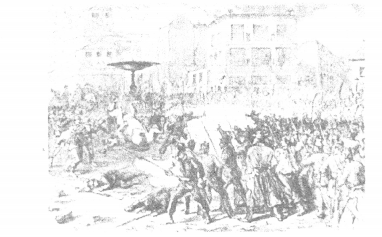
Which of the following options best signifies this scene?
(A) Painting of the Paris Commune of 1871
(B) Fighting on the streets of St. Petersburg between liberals and communists
(C) Revolt by common people against Lenin
(D) None of the above.
Answer:
Option (A) is correct.
Explanation: This is a painting of the Paris Commune of 1871. It portrays a scene from the popular uprising in Paris between March and May 1871. This was a period when the town council (commune) of Paris was taken over by a ‘peoples’ government’ consisting of workers, ordinary people, professionals, political activists, and others.
Question 4.
Unemployment leads to wastage of what type of resources? [1]
(A) Natural resources
(B) Human resources
(C) Artificial resources
(D) Renewable resources
Answer:
Option (B) is correct.
Explanation: Unemployment leads to a wastage of manpower resources as the educated and skilled youth is not having any employment opportunities.
Question 5.
There are two statements marked as Assertion (A) and Reason (R). Read the statements and choose the correct option
Assertion (A): Hitler was empowered to sideline Parliament and rule by decree.
Reason (R): The Enabling Act of 1935 established democracy in Germany. [1]
(A) Both Assertion (A) arid Reason (R) are true and Reason (R) is the correct explanation of Assertion (A).
(B) Both Assertion (A) and Reason (R) are true but Reason (R) is not the correct explanation of Assertion (A).
(C) Assertion (A) is correct but Reason (R) is wrong.
(D) Assertion (A) is wrong but Reason (R) is correct.
Answer:
Option (C) is correct. [1]
Explanation: On 3 March 1933, the famous Enabling Act was passed. This Act established a dictatorship in Germany. It gave Hitler all powers to sideline Parliament and rule by decree.
Question 6.
In which year Germany invaded Poland? [1]
(A) 1938
(B) 1934
(C) 1939
(D) 1945
Answer:
Option (C) is correct
Explanation: In 1939, Germany invaded Poland. It was a joint attack on the Republic of Poland by Nazi Germany, the Slovak Republic, and the Soviet Union. It marked the beginning of World War II.
Question 7.
Which is the most common form of democracy in today’s world? [1]
(A) Representative Democracy
(B) Direct Democracy
(C) Presidential Democracy
(D) Participatory Democracy
Answer:
Option (A) is correct.
Explanation: The most common form of democracy is representative democracy. Modern democracies involve such a large number of people that it is physically impossible for them to sit together and take a collective decision.
Question 8.
Who are India’s neighbours in the northwest? [1]
(A) Pakistan and Afghanistan
(B) Pakistan and China
(C) Mvanmar and Bangladesh
(D) Afghanistan and Bhutan
Answer:
Option (A) is correct.
Explanation: There are neighbouring countries of India. Pakistan and Afghanistan in the northwest, China, Nepal and Bhutan in the north; Myanmar and Bangladesh in the east, and Sri Lanka and Maldives in the South.
Question 9.
How can businesses be incentivised to hire more workers and reduce unemployment? [1]
(A) By reducing taxes on businesses
(B) By providing subsidies for oh creation
(C) By implementing a minimum wage
(D) Both (A) and (B)
Answer:
Option(D)is correct.
Explanation: Reducing taxes on businesses helps to provide the better salary and bonuses and providing subsidies for job creation helps to generate more employment.
Question 10.
A statement of Assertion (A) is followed by a statement of Reason (R). choose the correct option.
Assertion (A): The Himalayas represent the loftiest and one of the most rugged mountain barriers of the world.
Reason (R): The Himalayas are the most recent landforms [1]
(A) Both Assertion (A) and Reason (R) are true, and Reason to b the correct explanation of Assertion (A).
(B) Both Assertion (A) and Reason (R) are true, but Reason (R) is not the correct explanation of Assertion (A).
(C) Assertion (A) is true, but Reason (R) is false.
(D) Assertion (A) is false, but Reason (R) is true.
Answer:
Option (B) is correct.
Explanation: The Himalayas are the most recent young landforms. The Himalayas represent the loftiest and one of the most rugged mountain barriers of the world composed of rocks. They form an arc, which covers distance of about 2,400 km.
Question 11.
NSSO stands for ………………. .[1]
(A) National Sample Survey Organisation
(B) National Sampling Survey Organisation
(C) National Sample Survey Organised
(D) National Sample Surveyed Organisation
Answer:
Option (A) is correct.
Explanation: The poverty line is estimated periodically (normally every five years) by conducting sample surveys. These surveys are carried out by the National Sample Survey Organisation (NSSO).
Question 12.
Identify the most significant feature of the Indian population. [1]
(A) The size of its infant population
(B) The size of its old-age population
(C) The size of its adolescent population
(D) The size of its male population
Answer:
Option (C) is correct.
Explanation: The most significant feature of the Indian population ¡s the size of its adolescent population. It constitutes one-fifth of the total population of India. Adolescents are, generally, grouped in the age group of 10 to 19 years. They are
the most important resource for the future.
Question 13.
Monsoon arrives in India approximately in: [1]
(A) Early May
(B) Early July
(C) Early June
(D) Early August
Answer:
Option (B) is correct.
Explanation: The monsoon arrives at the southern tip of the Indian peninsula generally by the first week of June. Subsequently, it proceeds into two – the Arabian Sea branch and the Bay of Bengal branch.
Question 14.
Which is the coldest place in India? [1]
(A) Shimla
(B) Drass
(C) Kashmir
(D) Mussoorie
Answer:
Option (B) is correct.
Explanation: Situated at an elevation of 3,350 m, Drass is the coldest place in India and second to the coldest inhabited region on Earth. The average temperature on a winter night may be as low as minus 45°C.
Question 15.
What is the process for voter registration in India? [1]
(A) Automatic registration
(B) Voluntary registration
(C) Compulsory registration
(D) Biometric registration
Answer:
Option (B) is correct.
Explanation: In India, voter registration is voluntary. Citizens above the age of 18 can register to vote by filling out a form and submitting it to their local election office or online through the National ‘Voter Service Portal. Biometric registration is also available as an option for voters.
Question 16.
The apartheid government came to an end, paving the way for the formation of a …………………….. government. [1]
(A) multiracial
(B) multi-faced
(C) multi-ideated
(D) Both B and C
Answer:
Option (A) is correct.
Explanation: The apartheid government came to an end, paving the way for the formation of a multi-racial government. The official policy of radar separation and ill-treatment of blacks was followed by the Government of South Africa between 1948 and 1989.
Question 17.
Name the great leader of the Indian freedom movement who was not a member of the Indian Constituent Assembly. [1]
(A) Motilal Nehru
(B) Mahatma Gandhi
(C) Dr. Rajendra Prasad
(D) Dr. Bhimrao Ambedkar
Answer:
Option (B) is correct.
Explanation: Mahatma Gandhi was a great leader of the Indian freedom movement who was not a member of the Indian Constituent Assembly. He was an Indian lawyer and a political ethicist.
Question 18.
Which industry suffered the most during the colonial period? [1]
(A) Agriculture
(B) Textiles
(C) Raw Materials
(D) Manufacturing
Answer:
Option (B) is correct.
Explanation: The policies of the Colonial Government ruined traditional handicrafts and discouraged the development of industries like textiles.
Question 19.
What is the purpose of the implementation of a mid-day meal? [1]
(A) To encourage attendance and retention of children
(B) To tell the importance of food
(C) To add to the task of teachers
(D) To teach about food.
Answer:
Option (A) is correct.
Explanation: Mid-day meal scheme has been implemented to encourage attendance and retention of children and improve their nutritional status.
Question 20.
How can the education system be improved to better prepare students for the job market? [1]
(A) By focusing more on vocational raining
(B) 8v increasing funding for STEM programs
(C) By promoting apprenticeships and internships
(D) All the above
Answer:
Option (D) is correct.
Explanation: Vocational education should be encouraged so that people do not have difficulty getting jobs because they will be better trained for work.
Section-B
Very Short Answer Questions
(2 x 4 = 8 Marks)
Question 21.
What were Shaukat Usmani’s observations of Soviet Russia in 1920? [2]
Answer:
Shaukat Usmani observed that; ‘For the first time in our lives, we were seeing Europeans mixing freely with Asians. On seeing the Russians mingling freely with the rest of the people of the country we were convinced that we had come to a land of real equality.’
Question 22.
All governmental activities take place in the name of the President Discuss Describe the need for political institutions in India. [2]
Answer:
All governmental activities take place in the name of the President.
- All laws and major policy decisions of the government are issued in the name of the President.
- All major appointments are made in the name of the President.
- The government is responsible for ensuring security to the citizens and providing education and health facilities to all.
- It collects taxes and spends money on administration, defence, and developmental programmes.
- It formulates and implements several welfare schemes.
- Political institutions are needed to attend to all these tasks.
Question 23.
What are lamines? Who were the most affected group of the devastating famine of Bengal? [2]
Answer:
Meaning of famine: Famine can be defined as widespread deaths due to starvation and epidemics caused by the forced use of contaminated water or decayed food and loss of resistance due to weakening from starvation. The most affected
group: Agricultural labourers, fishermen, transport workers, and casual labourers.
Question 24.
Mention any two rights of a detained person. [2]
Answer:
- To be informed of the reason of arrest and detention.
- To be produced before the nearest magistrate within 24 hours of arrest.
Section- C
Short Answer-Based Questions
(3 x 5 = 15 Marks)
Question 25.
Mention the three major demands raised by Russian workers who went on strike at St. Petersburg in 1904. [3]
Answer:
The demands raised by the Russian workers:
- Reduction in the working day to eight hours.
- Increase in wages.
- Improvement in working conditions.
Question 26.
Describe any three features of the Purvanchal Range of the Himalayas. [3]
Answer:
Beyond the Dihang Gorge. the Himalayas bend sharply to the South and spread along the eastern boundary of India. These are known as the Purvanchal.
False
- Mostly composed of strong sedimentary rocks.
- It is covered with dense forests which mostly run parallel to ranges and valleys.
- It consists of Patkai Hills, Naga Hills, the Manipur, and the Mizo Hills.
Question 27.
What distinguishes democracy from other forms of government? Explain by giving three points. [3]
Answer:
Democracy is different from other forms of government because here:
- Citizens must take part in politics.
- Democracy depends on active political participation by all citizens.
- The fate of the country depends on not just who rules, but also on what we as responsible citizens do.
Question 28.
Explain the pattern of seasonal unemployment
OR
What has the government of India done to literate the population of the country? [3]
Answer:
seasonal unemployment occurs in a certain season of the year. It is a widespread phenomenon, for example. in agricultural practice. Agricultural practice is based on natural conditions. This means that at a certain period of time, there is heavy work while in the rest period, the work is lean. During the sowing of seeds and harvesting of crops, the agriculturist engages themselves the whole day and night. But after harvesting and sowing of seeds, the workers become work less.
True
True
Question 29.
Discuss the trend of poverty in India since 1973. [3]
Answer:
There has been a substantial decline in poverty ratios in India from about 55 percent in 1973 to 36 percent in 1993. The proportion of people below the poverty line further came down to about 26 percent in 2000. If the trend continues people below the poverty line may come down to less than 20 percent in the next few years.
Although the percentage of people living under the poverty line declined in the earlier two decades (1973 – 1993), the number of poor remained stable at around 320 million for a fairly long period. The latest estimate indicates a significant reduction
in the number of poor to about 26 million. [31
Section-D
Long Answer Based Questions
(5 x 4 = 20 Marks)
Question 30.
What is FCI? Write any four functions of FCI.
OR
“Unemployment leads to wastage of manpower resource.” Justify the statement with suitable examples. [5]
Answer:
FCI refers to the Food Corporation of India. The Food Corporation of India is a government agency that purchases food grains from farmers wherever they are in surplus. It helps the poor farmers of India to rise and earn. The main functions of Food Corporation of India are as under:
- Food Corporation of India helps in transportation of seeds and other kinds of food to major parts of the country.
- Food Corporation of India helps in storing and packaging of food items. The main function is to maintain the temperature of the food so that it does not get spoiled.
- Another function of Food Corporation of India is to maintain the quantity of food required
- One of the major functions of Food Corporation of India is to help in providing a proper price support to farmers.
- Because of unemployment, people who are an asset turn into a liability.
- There is a feeling of hopelessness and despair among youth.
- People don’t have money to support their families.
- Quality of life of an individual as well as society is adversely affected.
- When the family has to live in bare subsistence level, there is decline in health.
- Wastage of natural resources is another factor which emerges due to unemployment.
Question 31.
What is the relationship between the citizens and the Government of Saudi Arabia as far as human rights are concerned? State in five points.
OR
“Prime Minister is the most important political institution in the country”. Justify the statement. [5]
Answer:
- Saudi Arabia is ruled by a hereditary king and the people have no role in electing or changing their rulers.
- The king selects the legislature as well as the executives. He appoints the judges and can change any of their decisions.
- Citizens cannot form political parties or any political organisations. Media cannot report anything that the monarch does not like.
- Every citizen is required to be Muslim. Non- Muslim residents can follow their religion in private, but not in public.
OR
Position: The Prime Minister is the most important political institution of the country He/she is the head of the government and all important decisions regarding the country are taken by him/her. He/she enjoys the real executive powers as head of the State.
True
- Allocation of departments and formation of Council of Ministers, their distribution of portfolios.
- Being the Chairman of the Cabinet, Prime Minister presides the meetings of the Cabinet.
- Link between the President and Cabinet.
- Leader of the nation.
- Ex-officio chairman of the Planning Commission.
Question 32.
How can we involve the community in disaster prevention and response efforts?
OR
What measures can we take to minimise the economic impact of each type of disaster on businesses and individuals in our community? [5]
Answer:
Community involvement is crucial in disaster prevention and response efforts. One way to involve the community is to organise training sessions or drills to educate people on how to respond in case of a natural disaster. We can also encourage people to develop their own emergency plans and kits and share information about local risks and hazards. Additionally, we can work with local authorities or disaster management agencies to establish community-based early warnins systems, evacuation plans and other preparedness measures.
OR
Natural disasters can have a significant economic impact on businesses and individuals in a community. While it’s impossible to completely eliminate the economic impact of a disaster, there are measures that can be taken to minimise it. For example. businesses can develop continuity plans to ensure that critical operations can continue during and after a disaster. Individuals can also take steps to protect their property and assets, such as purchasing insurance or investing in disaster-resistant building materials.
True
Question 33.
Explain any five features of Stalin’s collectivisation programme for peasants in Russia.
OR
What changes were seen in Russia after October Revolution of 1917? [5]
Answer:
- Party forced all peasants to cultivate in collective farms.
- The bulk of land and implements were transferred to the ownership of collective farms.
- Peasants worked on the land and the Kolkhoz profit was shared.
- Enraged peasants resisted the authorities and destroyed their livestock.
- Those who resisted collectivisation were severely punished.
OR
Changes were:
- Most of the industries and banks were nationalised in November 1917.
- Land was declared social property.
- In cities, Bolsheviks enforced the partition of large houses according to family requirements.
- Banned the use of the old titles of aristocracy.
- New uniforms were designed for the army and officials.
Section-E
Case-Based Questions
(4 x 3 = 12 Marks)
Question 34.
Read the source given below and answer the questions that follow: (1 + 1+1+1=4)
The main water divide in Peninsular India is formed by the Western Ghats, which runs from north to south close to the western coast. Most of the major rivers of the Peninsula, such as the Mahanadi, the Godavari, the Krishna and the Kaveri flow eastwards and drain into the Bay of Bengal. These rivers make deltas at their mouths. There are numerous small streams flowing west of the Western Chats. The Narmada and the Tapi are the only long rivers, which flow west and make estuaries. The drainage basins of the peninsular rivers are comparatively smaller in size. [NCERT]
1. Which Indian river forms an estuaries?
2. Why are most of the Peninsular river draining into the Bay of Bengal?
3. How are the eastern ghats and western ghats are different?
Answer:
1. Narmada and the Tapi
2. The Eastern Ghats are lower than the Western Chats and are also discontinuous thus making it easier for the rivers to reach the Bay of Bengal.
3. The Western Chats continuous and can be crossed through passes only. But the Eastern Chats has been divided into several parts by large rivers. Western Ghats average elevation is 900 to 1,100 meters above sea level, But the average elevation of Eastern Chats is about 600 meters above sea level.
Question 35.
Read the source given below and answer the questions that follow: (1+1+2=4)
The year 1904 was a particularly bad one for Russian workers. Prices of essential goods rose so quickly that real wages declined by 20 percent, The membership of workers’ associations increased dramatically. When four members of the Assembly of Russian Workers, which had been formed in 1904, were dismissed at the Putilov Iron Works, there was a call for industrial action. Over the next few days over 1,10,000 workers in St. Petersburg went on strike demanding a reduction in the working day to eight hours, an increase in wages, and an improvement in working conditions.
When the procession of workers led by Father Gapon reached the Winter Palace it was attacked by the police and the Cossacks. Over 100 workers were killed and about 300 wounded. The incident, known as Bloody Sunday, started a series of events that became known as the 1905 Revolution. Strikes took place all over the country and universities closed clown when student bodies staged walkouts, complaining about the lack of civil liberties. lawyers, doctors, engineers, and other middle-class workers established the Union of Unions and demanded a constituent assembly.
1. In the year 1904, the real wages of Russian workers declined by what percentage?
2. What was the demand of the workers on strike at St. Petersburg?
3. Name a few series of events that took place during the 1905 Revolution.
Answer:
- In 1904, the real wages of Russian workers declined by 20 percent.
- At St. Petersburg, workers on strike were demanding a reduction in the working hours to eight hours
- Strikes took place all over the country and universities closed down when student bodies staged walkouts, complaining about the lack of civil liberties. Lawyers, doctors, engineers, and other middle-class workers established the Union of Unions and demanded a constituent assembly.
Question 36.
Read the source given below and answer the questions that follow: (1+1+2=4)
Once the election results were announced, the sitting Chief Minister resigned. The newly elected Members of the Legislative Assembly (MLAs) of Lok Dal chose Devi LaI as their leader. The Governor invited Devi Lal to be the new Chief Minister. Three days after the election results were declared, he became the Chief Minister. As soon as he became the Chief Minister, his government issued a Government Order waiving the outstanding loans of small farmers, agricultural labourers, and small businessmen. I-lis party ruled the State for four years. The next elections were held in 1991. But this time his party did not win popular support. The Congress won the election and formed the government.
1. Which party was formed by Chaudhary Devi Lal?
2. In 1991 State Assembly Elections in Haryana were won by the which party?
3. What was the promise Chaudhary Devi Lai made to the farmers and small businessmen?
Answer:
1. lokdal
2. Congress
3. Chaudhary Devi Lai promised farmers and small merchants, businessmen that their loans would be waived if he won the elections.
Section-F
Map Skill-Based Questions
Question 37.
(A)
(1) On the given political map of the world, locate and label: Turkey
(2) Identify the nation that was an allied power during World War II.
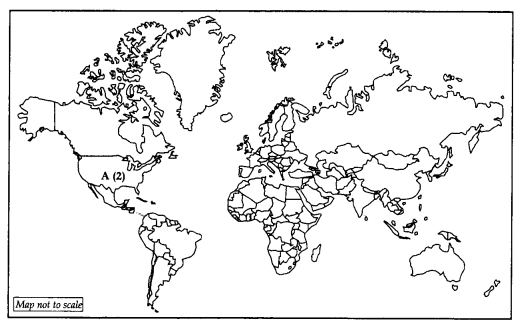
Answer:
(A)
(1) Belgium
(2) U.S.A.
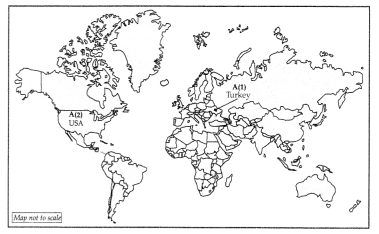
(B)
(1) On the given political map of India, locate and label the following:
(i) Chota Nagpur Plateau
(ii) Konkan
(2) Identify the river in the map.
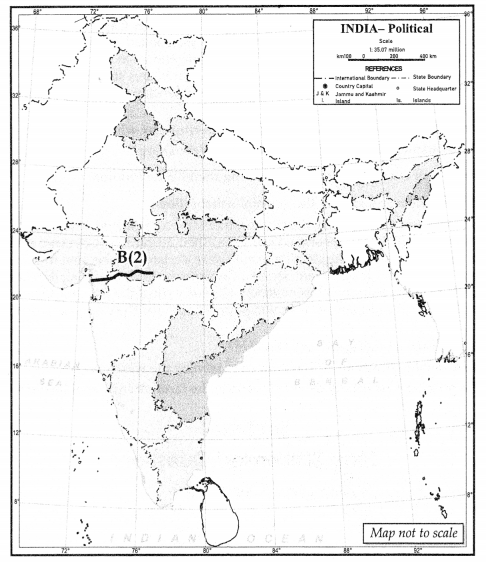
Answer:
(B)
(1)
(i) Chota Nagpur Plateu
(ii) Konkan
(2) River Tapi
